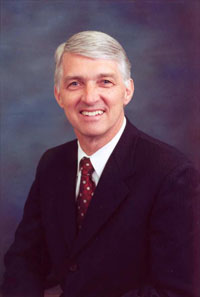GUADALAJARA, MEXICO — In another post, I’ll explain why I’m in Mexico for the next two weeks, and how I came to attend a conference sponsored by the UN’s Food and Agriculture Organization, titled “Agricultural biotechnologies in developing countries: Options and opportunities in crops, forestry, livestock, fisheries, and agro-industry to face the challenge of food insecurity and climate change.”
For now, I want to report on a fascinating interaction I had there with Roger Beachy, director of the USDA’s newly formed National Institute of Food and Agriculture.
First, a little context. NIFA, as it is known, is essentially the USDA’s research wing — it sets the agenda for the kind of research the agency funds. Meaning NIFA may have a pretty substantial effect on the kind of food system we’ll have in the future, because today’s research shapes tomorrow’s farming.
As I and others have reported before, Beachy ascended to the NIFA post from a long-time perch at the Danforth Plant Science Center in St. Louis, which he led from 1999 until last year. The Danforth Center, a non-profit research institute associated with Washington University in St. Louis, describes itself like this:
The Danforth Center was founded in 1998 through gifts from the St. Louis-based Danforth Foundation, the Monsanto Fund (a philanthropic foundation), and a tax credit from the State of Missouri.
The Danforth Center’s ties to GMO seed giant Monsanto run deep; Monsanto CEO Hugh Grant sits on Danforth’s board of directors, along with several others associated with the agrichemical giant.
It seems safe enough to call Danforth Monsanto’s not-for-profit research wing; and to describe Beachy is an industrial-ag man through and through. His performance at the FAO conference did nothing to dispel that notion.
From what I can tell, the confab, which took place at a sterile Hilton in a nondescript section of Guadalajara, hinges on the notion that GMO seeds are the only hope for the future of human existence on planet Earth — and that farmers in “developing countries” are pining to use them. In other w Roger Beachy, head of NIFA (USDA photo)ords, the question isn’t whether patent-protected biotechnology is appropriate for small-scale farming in the global south; but rather how best to establish it there.
Roger Beachy, head of NIFA (USDA photo)ords, the question isn’t whether patent-protected biotechnology is appropriate for small-scale farming in the global south; but rather how best to establish it there.
Ironically, as I’ll show in a later post, farmers — most glaringly Mexican farmers — were all but banned from attending. (This small farmer was waved in after flashing his Grist business card.)
Earlier today, I approached Beachy after a breakout session he moderated on how best to train developing-nation scientists in the techniques of biotechnology.
I introduced myself and handed him my business card. “Oh, we know Grist,” he said affably. “Don’t you guys have an interesting take on improved crops?”
“We try to have an interesting take on everything,” I replied with a grin. “Including quote-unquote improved crops.” I then asked if he would be available to take a few questions on the record.
At this point, a woman named Rachel Goldfarb moved into our conversation. Identifying herself as Beachy’s chief counsel, she informed me that he couldn’t give interviews without the approval of the USDA’s communications department. I replied that I would happily initiate that process in hopes of a future interview, and we exchanged business cards.
But then Beachy and I proceeded to have a short, cordial back-and-forth anyway. He said he was only interested in conducting interviews that directly pertained to science; he wasn’t keen to hash out people’s “spiritual objections” to GMOs.
I replied that I was mainly interested in hearing about NIFA’s research priorities. In certain parts of the USDA bureaucracy — I was thinking about Deputy Commissioner Kathleen Merrigan, but didn’t mention her — organic agriculture is taken quite seriously. Would NIFA be funding research for organic ag?
Beachy’s reply stunned me — and it also, I think, stunned his chief counsel. “I’m concerned about the safety of organic food,” he said. Come again? “I’m concerned about the issue of microbial contamination with organic….”
At this point, Goldfarb cut him off. “This is just the sort of thing he should not be discussing without approval,” she said. This conversation, she indicated, was over. We then shook hands and took our leave.
“Microbial contamination” of organic food … I assume Beachy was referring to the fact that organic farmers rely on manure (along with nitrogen-fixing cover crops) for fertility, whereas conventional farmers rely mainly on synthetic nitrogen. And manure, I surmise, carries microbes, so, watch out for organic!
There’s an irony here. Beachy’s agency, the USDA, oversees organic standards; and the rules are very strict about how manure can be used in crops systems. To put it briefly, manure can’t be applied unless it’s a) well-composted, which destroys pathogens; or b) has been aged in the field for at least 120 days before harvest.
By the way, in areas near concentrated-animal feedlot operations (CAFOs), conventionally managed cropland gets routinely doused by raw manure as a fertilizer — and regulation of this practice is notoriously lax.
Irony aside, I got the impression from Beachy that NIFA won’t be directing much research cash at organic ag. But I still hope to get that interview, and will proceed through the proper channels in hopes of making it happen.



